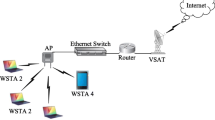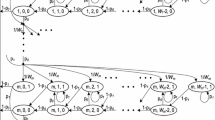Abstract
With the ever-increasing requirement of WLAN to support real-time services, it is becoming important to study the delay properties of WLAN protocols. This paper constructs a new model to analyze the channel access delay and delay jitter of IEEE 802.11 DCF in saturation traffic condition. Based on this analytical model, average channel access delay and delay jitter are derived for both basic access and RTS/CTS-based access scheme. The accuracy of the analytical model is validated by simulations and furthermore we discuss the impact of initial contention window, maximal backoff stage, and packet size on channel access delay and delay jitter of 802.11 DCF using the proposed model.
Similar content being viewed by others
References
IEEE standard for wireless LAN medium access control (MAC) and physical layer (PHY) specifications, 1999 Edition.
Bianchi G. (1998). IEEE802.11 – Saturation throughput analysis. IEEE Communication Letters 2:318–320
Binachi G. (2000). Performance analysis of the IEEE 802.11 distributed coordination function. IEEE Journal on Selected Areas in Communications 18(3):535–547
Wu, H., Peng, Y., Long, K., & Chen, S. (2002). Performance of reliable transport protocol over IEEE 802.11 wireless LAN: Analysis and enhancement. In Proceedings of IEEE INFOCOM’02 Vol. 2, pp. 599–607.
Ye, F., Yi, S., & Sikdar, B. (2003). Improving spatial reuse of IEEE 802.11 based ad hoc networks. In Proceedings of IEEE GLOBECOM’03, Vol. 2, pp. 1013–1017.
Wang C., Li B., Li L. (2004). A new collision resolution mechanism to enhance the performance of IEEE 802.11 DCF. IEEE Transactions on Vehicular Technology 53(4):1235–1246
Zaki, A. N., & El-Hadidi, M. T. (2004). Throughput analysis of IEEE 802.11 DCF under finite load traffic. In Proceedings of First International Symposium on Control, Communications and Signal Processing, pp. 535–538.
Chatzimisios, P., Boucouvalas, A. C., & Vitsas, V. (2004). Performance analysis of IEEE 802.11 DCF in presence of transmission errors. In Proceedings of IEEE ICC’04, Vol. 7, pp. 3854–3858.
Li Y., Long K., Zhao W., Tan L. (2005). RWBO(pd, w): A novel backoff algorithm for 802.11 DCF. Chinese Journal of Computer Science & Technology 20(2):276–281
Wang, Y., & Bensaou, B. (2001). Achieving fairness in IEEE 802.11 DFWMAC with variable packet lengths. In Proceedings of IEEE GLOBECOM’01, Vol. 6, pp. 3588–3593.
Nandagopal, T., Kim, T.-E., Gao, X., & Bharghavan, V. (2000). Achieving MAC layer fairness in wireless packet networks. In Proceedings of ACM MobiCom’00, Boston, MA, Aug. 2000, pp. 87–98.
Xu S., Saadawi T. (2001). Does the IEEE802.11 MAC protocol works well in multihop wireless ad hoc networks? IEEE Communications Magazine 39(6):130–137
Mangold, S., Choi, S., May, P., Klein, O., Hiertz, G., & Stibor, L. (2002). IEEE 802.11e wireless LAN for quality of service (invited paper). In Proceedings of the European Wireless, Florence, Italy, February 2002, Vol. 1, pp. 32–39.
Jie, H., & Devetsikiotis, M. (2003). Designing improved MAC packet schedulers for 802.11e WLAN. In Proceedings of IEEE GLOBECOM’03, Vol. 1, pp. 184–189.
Chatzimisios, P., Boucouvalas, A. C., & Vitsas, V. (2003). IEEE 802.11 packet delay: A finite retry limit analysis. In Proceedings of IEEE Globecom, San Francisco, USA, Vol. 2, pp. 950–954.
Zanella A., Pellegrini F. (2005). Statistical characterization of the service time in saturated IEEE 802.11 networks. IEEE Communications Letters 9(3):225–227
Xiao Y. (2005). Performance Analysis of Priority Schemes for IEEE 802.11 and IEEE 802.11e Wireless LANs. IEEE Transactions on Wireless Communications 4(4):1506–1515
Ho, T., & Chen, K. (1996). Performance analysis of IEEE 802.11 CSMA/CA medium access control protocol. In Proceedings of PIMRC, Vol. 2, pp. 407–411.
Weinmiller J., Schläger M., Festag A., Wolisz A. (1997). Performance study of access control in wireless LANs: IEEE 802.11 DFWMAC and ETSI RES 10 HIPERLAN. Mobile Networks and Applications 2(1):55–67
Wang, G., Shu, Y., Zhang, L., & Yang, O. (2003). Delay analysis of the IEEE 802.11 DCF. In Proceedings of IEEE PIMRC, Vol. 2, pp. 7–10.
Carvalho, M. M., & Garcia-Luna-Aceves, J. J. (2003). Delay analysis of IEEE 802.11 in single-hop networks. In Proceedings of the 11th IEEE International Conference on Network Protocols (ICNP’03), pp. 146–155.
Ahn G.-S., Campbell A.T., Veres A., Sun L.-H. (2002). Supporting service differentiation for real-time and best-effort traffic in stateless wireless ad hoc networks (SWAN). IEEE Transaction on Mobile Computing 1(3):192–207
Zhai H., Kwon Y., Fang Y. (2004). Performance analysis of IEEE 802.11 MAC protocols in wireless LANs. Wireless Communication and Mobile Computing 4:917–931
The networks simulator ns-2, http://www.isi.edu/nsnam/.
Cole, R. G., & Rosenbluth, J. H. (2001). Voice over IP Performance Monitoring. ACM Computer Communication Review, April 2001.
ITU-T Recommendation G.107 (1998). The E-Model, a computational model for use in transmission planning. December 1998.
Author information
Authors and Affiliations
Corresponding author
Rights and permissions
About this article
Cite this article
Li, Y., Wang, C., Long, K. et al. Modeling Channel Access Delay and Jitter of IEEE 802.11 DCF. Wireless Pers Commun 47, 417–440 (2008). https://doi.org/10.1007/s11277-008-9491-4
Received:
Accepted:
Published:
Issue Date:
DOI: https://doi.org/10.1007/s11277-008-9491-4




